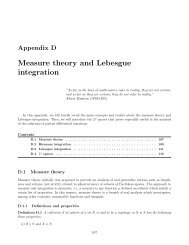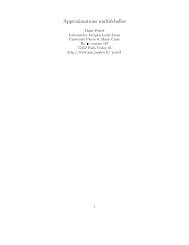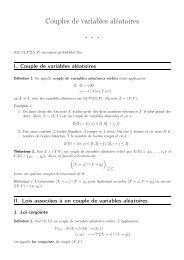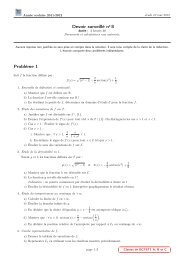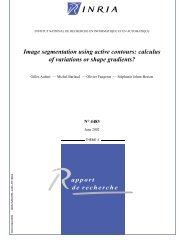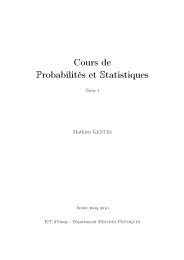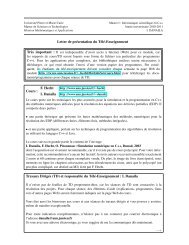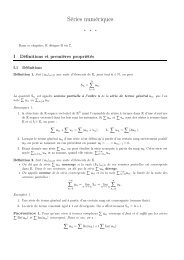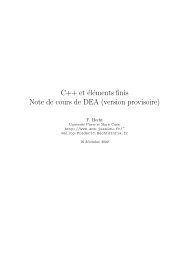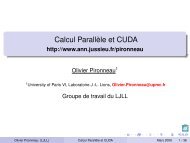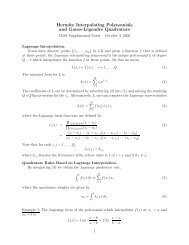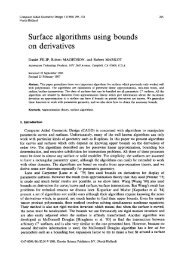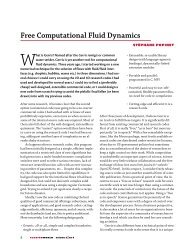Anisotropic Delaunay Mesh Adaptation for Unsteady Simulations
Anisotropic Delaunay Mesh Adaptation for Unsteady Simulations
Anisotropic Delaunay Mesh Adaptation for Unsteady Simulations
Create successful ePaper yourself
Turn your PDF publications into a flip-book with our unique Google optimized e-Paper software.
178 C. Dobrzynski and P. Frey<br />
part of the solution of a set of partial differential equations and thus it is not<br />
known by or described by an analytical model. Such surfaces can be successfully<br />
handled by level set <strong>for</strong>mulations [29] or implicit surfaces. In many cases,<br />
it is again more efficient to use anisotropic elements and to adapt the mesh to<br />
capture the interface or to follow the severe de<strong>for</strong>mations of the geometry. The<br />
goal of this paper is to provide such mesh adaptation features <strong>for</strong> unstructured<br />
simplicial meshes in view oftime-dependent and geometry evolving simulations.<br />
In general, anisotropic mesh adaptation aims at equidistributing the approximation<br />
error by adjusting locally the mesh density according to a metric tensor<br />
field based on the Hessian of the numerical solution [16, 18]. It relies on the ability<br />
to control the size, the shape and the orientation of the mesh elements. In<br />
addition to improving the accuracy of the solution, anisotropy allows to preserve<br />
the order of convergence of the computational schemes [19]. It has already been<br />
largely shown that highly stretched mesh elements can interpolate a smooth<br />
function much more accurately than an isotropic mesh with regular elements<br />
[3, 33, 34]. As we will emphasize here, anisotropic elements also have the advantage<br />
of introducing regularity in the approximation of interfaces between<br />
physical domains.<br />
The contributions of this paper are the following. First, it provides a general<br />
context <strong>for</strong> anisotropic <strong>Delaunay</strong>-based mesh adaptation in three dimensions,<br />
based on a local point insertion procedure. In this respect, it can be considered<br />
as an extension of previous works on anisotropic meshing <strong>for</strong> complex domains<br />
[7, 9, 12, 13, 22, 32]. It can also be related to computational geometry results on<br />
<strong>Delaunay</strong> insertion of Steiner points in a triangulation, sometimes called point<br />
placement methods [11, 26]. However, here we provide a straight<strong>for</strong>ward andconvergent<br />
algorithm to locally adapt the mesh elements to any anisotropic metric<br />
tensor. Furthermore, we show how aslight modification of the <strong>Delaunay</strong> kernel<br />
allows us to prevent the generation of badly-shaped elements. Since our approach<br />
is based on local mesh modifications, the termination of the algorithm is straight<strong>for</strong>ward,<br />
although the resulting triangulation fulfill the <strong>Delaunay</strong> criterion only<br />
locally. Second, this paper explains how to build an anisotropic metric tensor <strong>for</strong><br />
level set interface tracking, following the ideas of [14]. Then, we show how this<br />
method can be efficiently used to resolve fluid-structure interactions and moving<br />
mesh problems where the computational domain geometry undergoes large<br />
displacements. We demonstrate benchmark and simulation results on rigid-body<br />
and on fluid dynamics simulations. For the sake of simplicity however, we will<br />
assume in all these simulations that the initial surface mesh is not concerned by<br />
adaptation. The local adaptation of surface meshes has been largely discussed in<br />
other papers over the last years (surveys can be found in [17, 27], <strong>for</strong> instance).<br />
The remainder of this paper is organized as follows. In Section 2,we review the<br />
main issues of anisotropic mesh adaptation based on Riemannian metric tensors.<br />
This notion of an anisotropic metric tensor has been described in a general<br />
purpose book [18] and in many research papers. In particular, we outline the<br />
definition of a metric tensor, the notion of metric intersection and interpolation.<br />
In Section 3, we show how the classical <strong>Delaunay</strong> mesh generation procedure can



